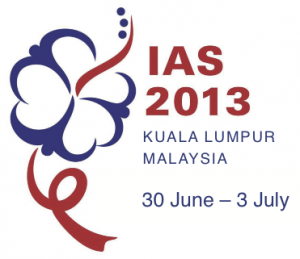Partner-dependent immune differences may protect against HIV infection
25 July 2013. Related: Conference reports, HIV prevention and transmission, IAS 7th Kuala Lumpur 2013.

Simon Collins, HIV i-Base
An interesting poster at IAS 2013 looked at the association between HLA incompatability of sexual partners as a mechanism for protection against sexual transmission. [1]
Wim Jennes from the Institute of Tropical Medicine, Antwerp presented results from a study of 108 Senegalese couples enrolled in a cohort in Dakar. This included 35 sero-different couples, 35 where both partners were HIV positive and 38 where both partners are HIV negative.
The hypothesis for potential protection was based on the role that killer immunoglobulin-like receptors (KIR) which regulate natural killer (NK) innate immune responses in susceptibility to HIV infection and that KIR respond to HLA expression on target cells. The group has previously published on how KIR/HLA patterns could explain protection from HIV in a group of multiply-exposed HIV negative sex workers. [2]
KIR contain two or three external Ig-like domains (2D, 3D) with either long (2DL, 3DL) or short (2DS, 3DS) tails, corresponding to their function as inhibitory or activating receptors, respectively and can have strong or weak binding affinities to specific HLA.
NK cells from HIV negative donors were co-cultured with HIV positive patient-derived CD4 cells to look at NK cell-mediated CD4 T-cell killing as a function of KIR/HLA.
In terms of autologous NK cell function and KIR frequencies, HIV negative partners (in the serodifferent group) had significantly lower levels of 2DL3 (p=0.001) and higher levels of both 2DL2 (p=0.036) and 2DS2 (p=0,049) compared to HIV positive people (partners in the HIV positive couples). When looking at KIR/HLA frequencies, HIV-negative people were more frequently KIR2DL2 hmz (centromeric KIR BB) and HIV positive people were more frequently KIR2DL3 hmz (centromeric KIR AA).
Allogenic NK cell function, targeting incoming HIV-infected cells from the HIV positive partner, regulated by allogeneic KIR/HLA compatibility between partners (based on studies from stem cell transplants) showed similar associations. HIV-different couples showed a higher frequency of a missing self KIR/HLA combination while HIV-concordant couples showed a higher frequency of a matched KIR/HLA combination. 2DL1+C1/C1 was present in approximately 3% vs 22% and 2DL3/L3+C1/C2 in 33% vs 3%, in HIV positive vs HIV-different couples respectively. In multivariate analysis, matched and missing self allogeneic KIR/HLA combinations, but not recipient KIR genotype, independently predicted couple HIV status.
In the in vitro studies with HIV negative cells, significantly higher levels of alloreactive NK cell-mediated CD4 killing were seen for missing self KIR/HLA combinations.
comment
The complexity of factors that compound to allow or block sexual transmission are numerous and complex, and range from biomedical determinants to behavioural risks. In terms of individual per-exposure risks reference ranges (approximately 1 in 200-500 in someone not on treatment) suggest that HIV is a difficult virus to transmit.
Conversely, only one exposure is needed for transmission to occur. Anecdotally, some people are unlucky in this corresponding to a single unprotected risk while others remain protected after numerous risks over many years with an HIV positive partner, even when condoms are not used.
Although free virus is usually referred to as the cause of infection, HIV-1 transmission may occur at least in part via HIV infected cells from the sexual partner. These cells can penetrate deeply in the recipient’s mucosal tissues and continue to produce infectious virus. The relative contribution of free virus and infected cells in causing transmissions is not known. The current hypothesis from this group is that the allogeneic KIR/HLA mismatches protect against these incoming infected cells.
Once infection is established, even if this is by free virus from the sexual partner, they suggest that an early mucosal infection in the recipient could then still be cleared by autologous activating KIR/HLA genotypes in the recipient partner. They also speculate that that alloreactive KIR/HLA combinations target free virus from the sexual partner, because free virus is known to carry the HLA molecules from the host cells in abundance on the viral membrane. The mechanism for this requires further study.
A previous analysis of these couples, published in PLoS One, reported a high phylogenetic linkage between the positive couples (74% linked, 13% indeterminate, 13% unlinked) that corresponded to interview data on behavioural risk. [3]
Also, that although condom use is now high in the serodifferent couples, and that many of the HIV positive partners have suppressed viral load due the ART, the negative partners still represent selected survival because they went through a period of high infection risk (when HIV status was not known, no condom use and no ART). These issues are expanded on in the published findings from this study in the journal Blood. [4]
This research provides insight into further understanding the genetic factors affecting transmission and is important for highlighting how these may be specifically partner dependent.
References:
- Jennes W et al. Inhibitory KIR/HLA incompatibility between sexual partners confers protection against HIV-1 transmission. 7th IAS Conference on HIV Pathogenesis, Treatment and Prevention, 30 June – 3 July 2013, Kuala Lumpur. Poster abstract TUPDA0103.
http://pag.ias2013.org/Abstracts.aspx?SID=10&AID=1560 (abstract)
http://pag.ias2013.org/EPosterHandler.axd?aid=1560 (poster) - Jennes W et al. Cutting Edge: Resistance to HIV-1 infection among African female sex workers Is associated with inhibitory KIR in the absence of their HLA ligands. Journal of Immunology, 15 November 2006;177(10):6588-6592. Free full text.
http://www.jimmunol.org/content/177/10/6588.long - Jennes W et al. Molecular epidemiology of HIV-1 transmission in a cohort of HIV-1 concordant heterosexual couples from Dakar, Senegal. PLoS One. 2012;7(5):e37402. doi: 10.1371/journal.pone.0037402. Epub 2012 May 17.
http://www.plosone.org/article/info%3Adoi%2F10.1371%2Fjournal.pone.0037402 - Jennes W et al. Inhibitory KIR/HLA incompatibility between sexual partners confers protection against HIV-1 transmission. Blood. 2013 Feb 14;121(7):1157-64. doi: 10.1182/blood-2012-09-455352. Epub 2012 Dec 13.
http://www.ncbi.nlm.nih.gov/pubmed/23243280

